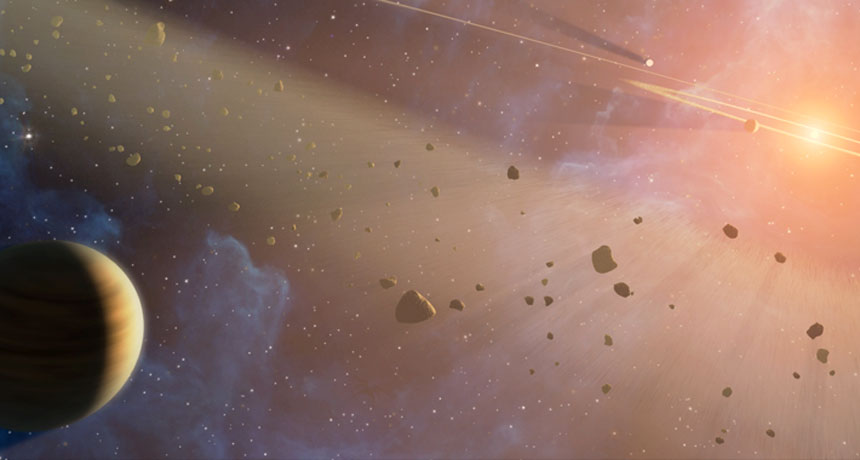
KABOOM Asteroids and comets that smashed into the planet billions of years ago, as in this illustration, could have provided the necessary energy to hot-wire life, new experiments suggest.
NASA
Asteroids and comets that pummeled the solar system billions of years ago may have jump-started life on Earth with an intense zap of energy.
The jolt given off by such explosive impacts would have been strong enough to spark the formation of genetic molecules, scientists report December 8 in the Proceedings of the National Academy of Sciences. Using a high-power laser, the researchers simulated how the collisions’ energy might smash apart a simple primordial chemical into reactive fragments. The researchers spotted the building blocks of genetic material called nucleobases among the molecular rubble.
“We were looking for the simplest possible scenario in which these nucleobases could have formed,” says planetary scientist David Nesvorný of the Southwest Research Institute in Boulder, Colo. “When things are simple it’s more likely that they occurred somewhere.”
The uncomplicated chemical that Nesvorný and his colleagues used in their study was formamide, a nitrogen-containing organic compound that forms a smelly liquid. Its simple structure makes formamide a likely inhabitant of early Earth, and previous studies found that it can break apart and recombine to form nucleobases. But those earlier chemical reenactments of the origin of nucleobases relied on an array of catalysts, such as silica and limestone. Nesvorný and colleagues relied on collision energy.
“These impacts of the past had enormous energy,” Nesvorný explains. Picture a 50- to 100-kilometer-wide asteroid barreling into the Earth at 10 to 20 kilometers per second, he says. The impact is like an explosion, blasting electrons off terrestrial atoms and forming highly reactive plasma that can spur unusual chemical reactions.
And such molecular cataclysms were regular events about 4 billion years ago — a period marked by the Late Heavy Bombardment, in which Earth was hit by as much as a billion tons of space shrapnel a year. That time coincides with the origin of nucleobases.
Nesvorný and his colleagues simulated the energized aftermath of such collisions by shooting a small pool of formamide with a high-power laser. In the resulting plasma, some formamide molecules broke down, creating radical debris. Those radical molecules attacked the remaining formamide to create 2,3-diaminomaleonitrile, which went on to form nucleobases.
The radicals are key, says physical organic chemist Yassin Jeilani at Spelman College in Atlanta. Before the new study, scientists knew that radicals could transform formamide into nucleobases, but it was unclear whether collision energy could let radicals loose.
Using spectroscopy to examine the zapped formamide, Nesvorný and colleagues found the nucleobases of RNA, a type of genetic material. An intermediate in the process using information encoded in DNA to make proteins, RNA is commonly believed to have been Earth’s pioneering hereditary molecule. RNA’s nucleobases include adenine, cytosine and guanine, which are also found in DNA, plus uracil (DNA contains thymine instead of uracil).
In their experiment, Nesvorný and his colleagues found RNA’s A’s, G’s, and U’s, but the researchers needed to add clay to the experiment to produce C’s. The clay, the researchers hypothesize, helped stabilize the C’s and prevent them from chemically transforming into U’s..
“The results are exciting,” says chemist Hicham Idriss of the King Abdullah University of Science and Technology in Thuwal, Saudi Arabia. But, he says, the simple experimental setup might be limited. If other chemicals, such as catalysts, had been around, perhaps the scientists would have glimpsed the nucleobases begin to assemble into full-fledged genetic matter.
For now, Nesvorný says that the finding is a step closer to understanding how life on Earth began. And, he says, since other planets in the solar system experienced the same massive impacts, perhaps the research could one day help explain the origin of any life that might be found elsewhere.






